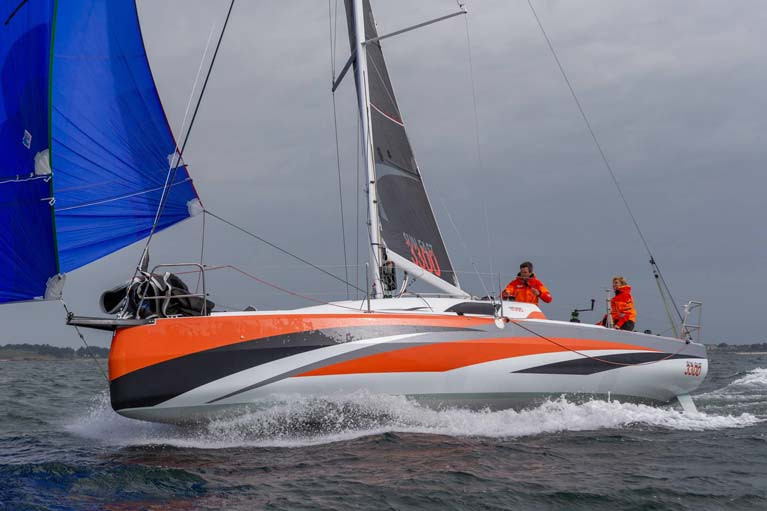Displaying items by tag: Sunfast
We were having one of those brainstorming discussions the other day about how best to promote sailing in Ireland, when some still small voice suggested that we were going at the challenge entirely the wrong way. We were thinking in terms of promotional campaigns and more sociable events afloat and various outreach projects and targeted material and focus groups and role models and - so help us all - celebrity involvement and endorsements.
But the trip-everyone-up-counter-thought was based on the fact that – as we’ve repeated here ad infinitum – sailing is first and last and foremost a vehicle sport. Get the vehicles right and get them in a sociable race format, said the still small voice, and the people will come and get involved.
And what is the right sailing vehicle? It’s a sporting boat which optimizes the amount of performance and fun that you get in relation to the effort involved, with that effort expended in a user-friendly set-up in which the proven protocols of ergonomics are not merely acknowledged, rather they are regarded as the Sacred Scriptures.
It’s all very well for fit and agile young folk to sport around in demanding classic craft in which every feature seems to be hard angles and vertical seatbacks, awkward sail controls, conspicuously absent footholds and hand grabs, and badly-designed companionways. But when the years pile on, and you’re coping with various chronic conditions all of which end in “is” (though admittedly there’s no sign of myxomatosis so far, it’s early days yet), you become very appreciative when a lot of thought has been put into how a boat’s layout is going to work.
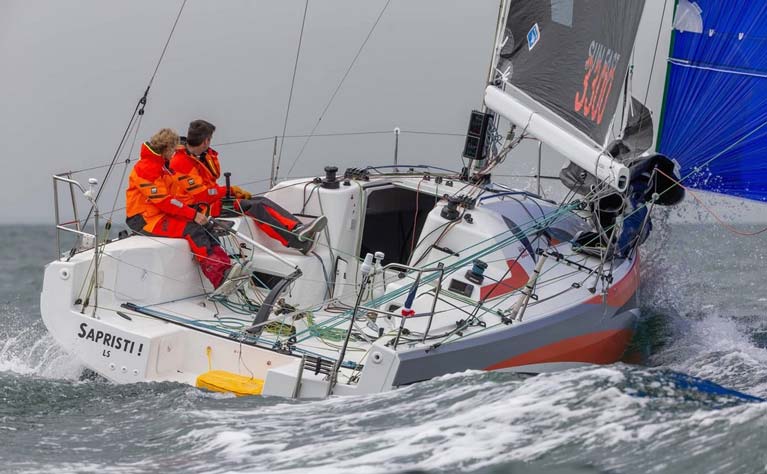 Very much a cruiser-racer cockpit with the emphasis on racing, yet within those limits, the ergonomics are sensible for comfortable sailing, and the foot-bars for the helm are of a sensible size
Very much a cruiser-racer cockpit with the emphasis on racing, yet within those limits, the ergonomics are sensible for comfortable sailing, and the foot-bars for the helm are of a sensible size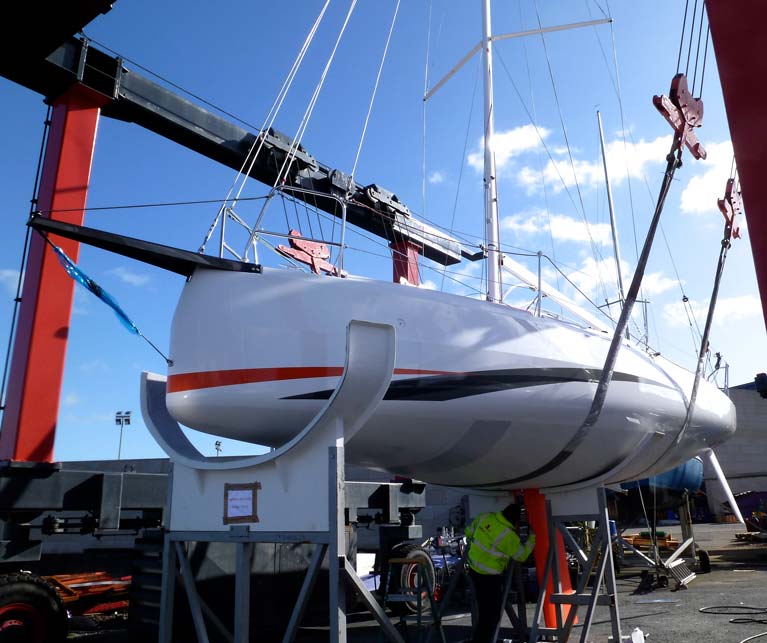 Ideas from outside the box become mainstream – “fascinating” is just the beginning of it as you contemplate the new Sun Fast 3300. Photo: W M Nixon
Ideas from outside the box become mainstream – “fascinating” is just the beginning of it as you contemplate the new Sun Fast 3300. Photo: W M Nixon
And there’s every sign that a properly functional user-friendly set-up has been a priority in putting the new Sun Fast 3300 together, as became apparent during a shoreside appraisal at the MGM Boatyard in Dun Laoghaire early this week where the first Sun Fast 3300 to arrive in Ireland was being prepared for launching by Sales Director Ross O’Leary and Simon Litwin.
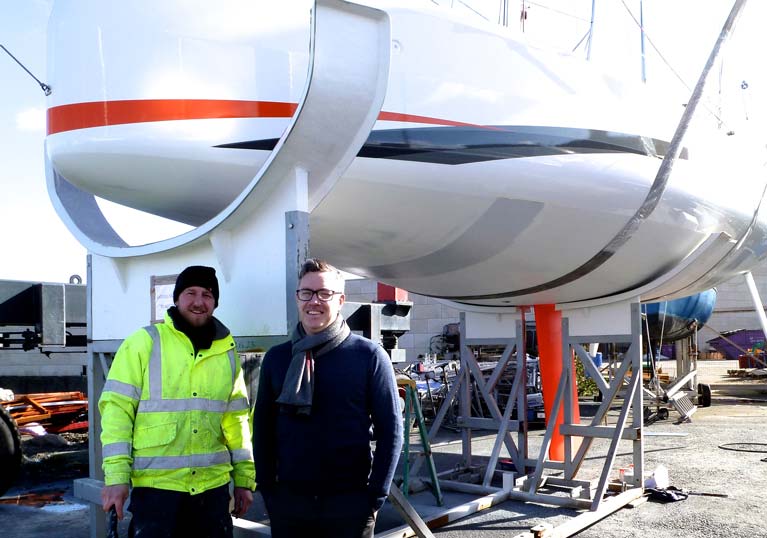 Simon Litwin and Ross O’Leary of MGM Boats with their new baby – the Sun Fast 3300’s apparent bulge amidships underwater is not an optical illusion, it’s very much part of the concept. Photo: W M Nixon
Simon Litwin and Ross O’Leary of MGM Boats with their new baby – the Sun Fast 3300’s apparent bulge amidships underwater is not an optical illusion, it’s very much part of the concept. Photo: W M Nixon
Traditionalists will need to take a bit of time getting used to her, with her reverse stem and rounded deck edge. For traditionalists will have a fondness for great big bursting bow-waves and lots of flying spray. But those great big bursting bow-waves and clouds of flying spray are evidence that the sea is doing everything it can to slow the boat back. So if you can manage to come up with a design which zips along leaving barely a trace, with minimal bow-wave and spray which just creams across the deck with no fuss at all, then you have yourself the makings of a fast boat.
In times past, fast boats went quickly through the water by having hollow waterlines forward to facilitate the progress of their heavy displacement hulls. But the Sun Fast 330 has rounded waterlines, yet in profile there’s a slight hollow after of the forefoot and forward of the fin keel. She will be going over the water as much as possible, which will reduce the inevitable spray across the deck
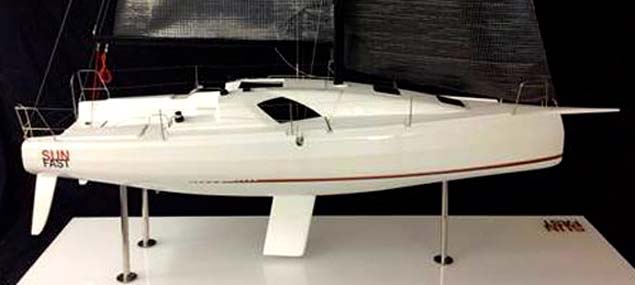 Full waterlines forward ingeniously combined with a hollow profile underwater, while the notion of stepped sides in the coachroof with forward-outlook windows is becoming mainstream.
Full waterlines forward ingeniously combined with a hollow profile underwater, while the notion of stepped sides in the coachroof with forward-outlook windows is becoming mainstream.
Technically speaking, we’re told these hollows on the centre line underwater “enable an improved distribution of dynamic pressure while limiting drag on the hull and minimizing the surface below the waterline for greater performance”. As for the fin keel, it rejects the use of a lead ballast bulb and other complications in favour of a simple shape to provide a reduction in drag and an optimized centre of gravity.
You’ve heard of modern fusion cuisine? Well, this is modern fusion yacht design, with outside-the-box ideas becoming mainstream. The two great talents involved in creating the very satisfying end result are no slouches when it comes to providing completely new ideas themselves, as the boat emerges from a collaboration between longtime Jeanneau associate Daniel Andrieu (who may be 73, but he thinks very young indeed), and Guillaume Verdier, who is in the flush of youth by today’s standards, as he’s only 49. But he has been in the sharp end of the design department of some very successful big global campaigns, and is refreshingly frank about his creative approach: “My desk is messy but my mind is clear”.
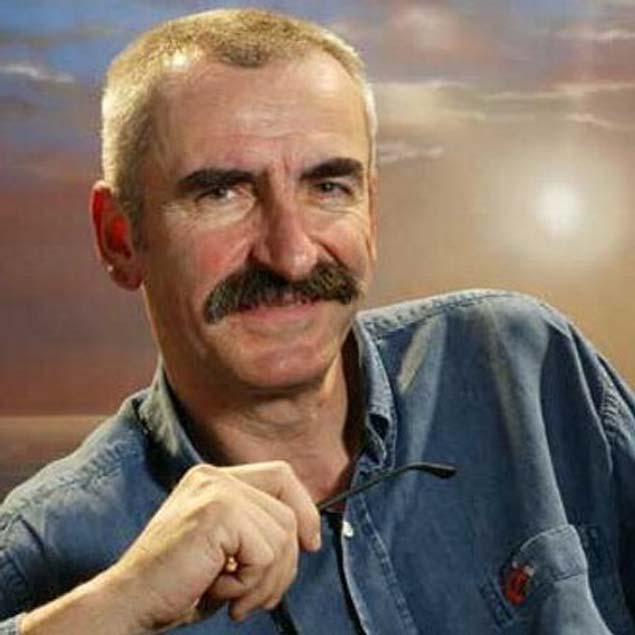 Daniel Andrieu has designed 16 boats for Jeanneau, yet he is still bursting with fresh ideas at the age of 73.
Daniel Andrieu has designed 16 boats for Jeanneau, yet he is still bursting with fresh ideas at the age of 73.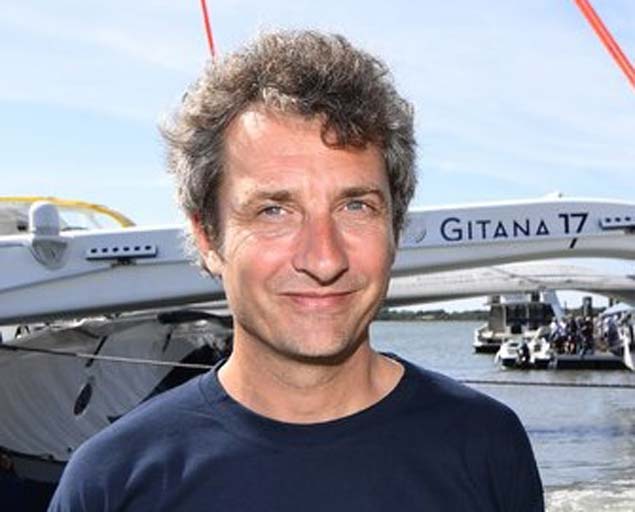 Rockstar designer Guillaume Verdier – “my desk is sometimes messy, but my mind is clear”
Rockstar designer Guillaume Verdier – “my desk is sometimes messy, but my mind is clear”
The very first prototype Sun Fast 3300s appeared last year just as everyone was notching up the excitement dial about the woman/man two-handed offshore boat for the 2024 Olympics, and they made such a favourable impression that many are already thinking of her in Olympic terms.
But some of us view sailing’s inevitable reliance on the four-year Olympic searchlight with very mixed feelings. While acknowledging that it’s one of the few ways in which our complex and quirky sport can make itself of attention for fickle global public interest, it would be a sad business if a boat as fascinating as the Sun Fast 3300 was seen mainly in the narrow yet distorting focus of the Olympic priority.
For she seems to be much too good a boat for just that one blinkered purpose. Here you have a boat which will undoubtedly provide optimum performance for a crew of two, yet will be rewarding and fun for a larger ship’s complement. She may be only 32ft 10 ins in overall length, but she’s all boat, and with that rounded bow - which pedants will ultimately trace to Ian Lipinsky’s pioneering MiniTransat boat Griffon 2 or even to the Buddy Melges American Lake Scows – she behaves like a bigger boat as she moves over rather than through the water.
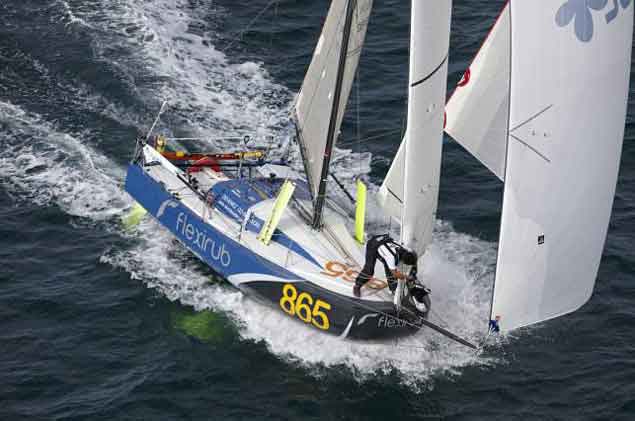 The full-bowed concept carried to its ultimate – Ian Lipinsky’s successful MiniTransat boat Griffon 2.
The full-bowed concept carried to its ultimate – Ian Lipinsky’s successful MiniTransat boat Griffon 2.
Yet while you will need extra-efficient foul weather gear to see off any unhindered spray which will come swiftly across the deck - for fast boats are usually wet boats - in every other way you’ll be as comfortable as possible in the cockpit, on deck, and particularly in the accommodation.
You’ll immediately notice the stepped side in the coachroof, which has become best known through its success on the all-conquering JPK 10.80. But while someone will doubtless claim that the idea was there before that particular great boat appeared, we’ll happily give all credit to Jean-Pierre Kelbert and his designer Jacques Valer for a design feature which confers multiple benefits.
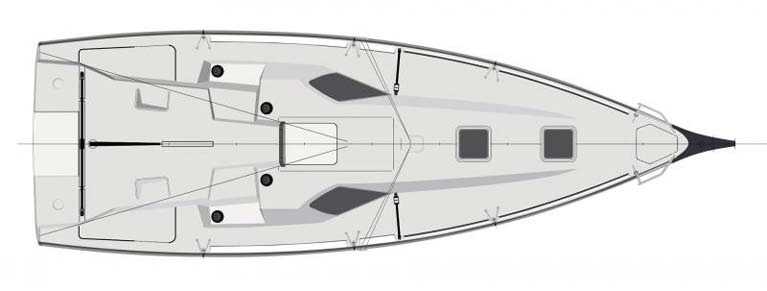 The deck plan indicates the potential which is released for better utilization of space when the stepped-side configuration is used in the coachroof design.
The deck plan indicates the potential which is released for better utilization of space when the stepped-side configuration is used in the coachroof design.
It leaves space on deck where it is most needed, yet provides space below where it is of added value. And while you may think that the ability to see clear ahead from down below is of limited benefit, believe me you’d be surprised the difference it makes. In my own case, it was during ten very happy years with a Hustler 30 which – unusually - had a porthole in the forward end of the coachroof, a feature which - on at least two occasions while anchored in a gale - made us readily aware that another boat was dragging down on top of us while there was still time to take avoiding action.
As for the great big “bee’s eyes” which are the forward-looking side windows on the Sun Fast 3300, they really do give remarkable vision so long as you’re sufficiently disciplined to also keep a proper on-deck lookout most of the time.
But even the toughest offshore campaigner needs to get in out of the elements now and again, and it’s good to see that the adjustable sea berths in the saloon have proper grown-up adjustment tackles. When the boat is at her optimum performance, comfortably sailing at an angle of 15 to 20 degrees thanks to the high level of control conferred by the twin rudders, it does no harm to remember that a crewman below tucked comfortably into the weather cot adjusted to the optimum angle actually has his or her body weight further outboard than some unfortunate perched on the weather rail with their legs over the side, exposed to the elements and straining every sinew to maximize leverage.
 While the accommodation is basic, it’s comfortable within its limits and makes clever use of the extra space and localized extra headroom provided by the stepped-side coachroof.
While the accommodation is basic, it’s comfortable within its limits and makes clever use of the extra space and localized extra headroom provided by the stepped-side coachroof. The easily adjusted cots optimize the usefulness of the weight below of the off-watch crew.
The easily adjusted cots optimize the usefulness of the weight below of the off-watch crew.
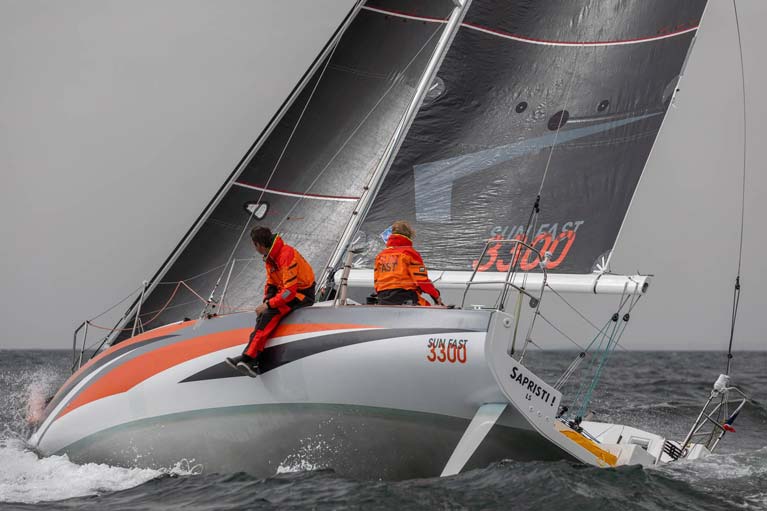 The effectiveness of twin rudders when the wedge-shaped hull is well-heeled is effectively demonstrated in this photo, but so too is the fact that the weight of the crew on the weather deck would actually be further outboard were they securely in the weather side adjustable cot below
The effectiveness of twin rudders when the wedge-shaped hull is well-heeled is effectively demonstrated in this photo, but so too is the fact that the weight of the crew on the weather deck would actually be further outboard were they securely in the weather side adjustable cot below
Having twin rudders has two disadvantages. As they’re located under each quarter, there’s no doubt that they’ll more easily get fouled by a trailing line than a centre-line rudder. But in most cases, that’s a lesson which is learned once and remembered forever.
The other disadvantage is that when manoeuvring into or out of a confined berth, you don’t have the instant boat-spinning power of prop thrust working directly on the rudder. But as the Sun Fast 3300 can spin like a top with the slightest way on, this is not the problem it would be with a boat with a longer keel.
As for the standard centre-line shaft-driven propeller, it indicates just how many experienced marine engineers still distrust SailDrive arrangements and other fancy set-ups where the entire propeller unit retracts into the boat. In the Sun Fast 3300 you’ve a time-tested shaft arrangement through a P-Bracket, but it has been usefully tidied up by having everything external enclosed within a neat housing which, apart from reducing turbulence, also reduces the number of ways in which floating lines and other detritus can become fouled in the external propshaft arrangement.
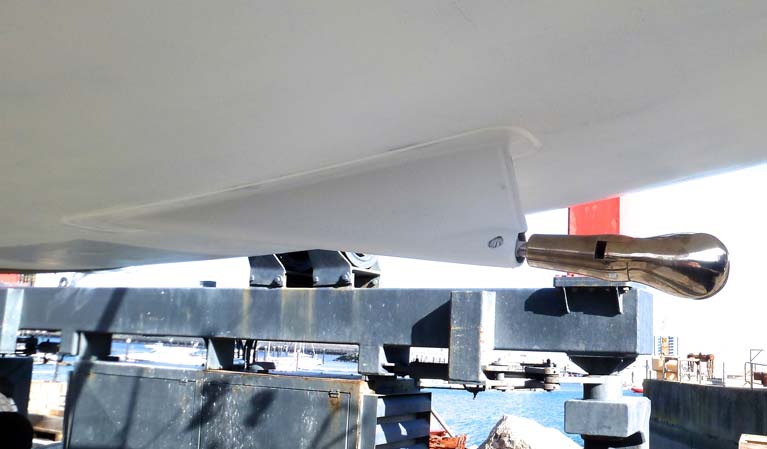 While the Sun Fast 3300 has a “traditional” propeller shaft operating through a P-bracket, all the externals are in this turbulence-reducing housing. Photo: W M Nixon
While the Sun Fast 3300 has a “traditional” propeller shaft operating through a P-bracket, all the externals are in this turbulence-reducing housing. Photo: W M Nixon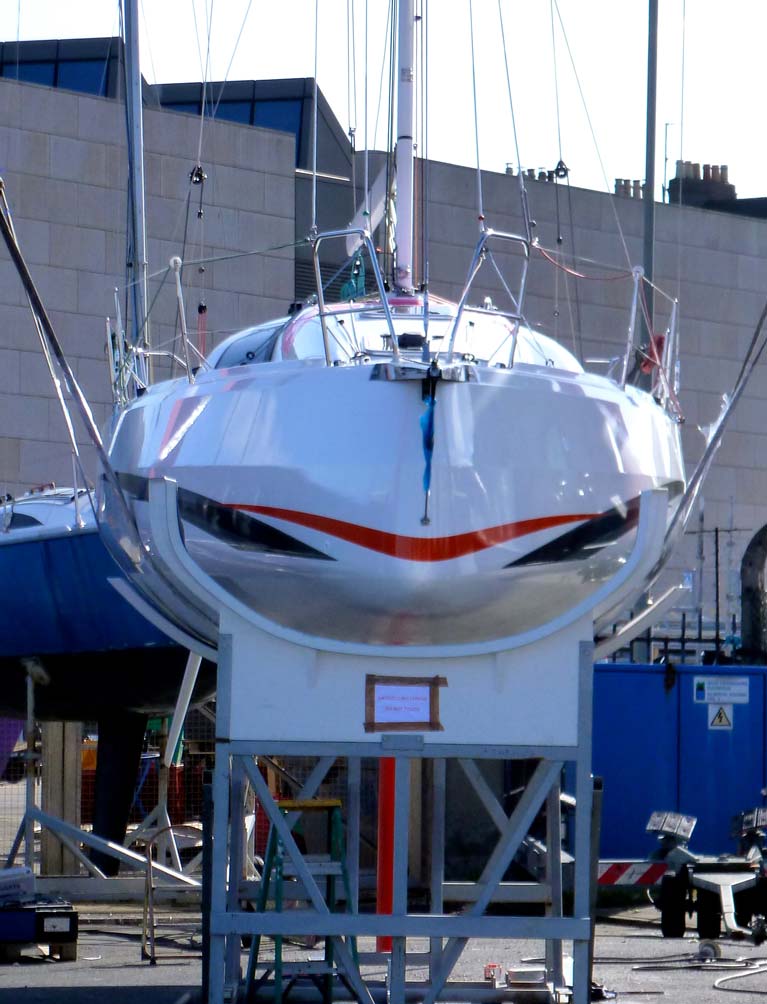 No matter which viewing angle is taken, this is one unusual-looking boat. Photo: W M Nixon
No matter which viewing angle is taken, this is one unusual-looking boat. Photo: W M Nixon
This is almost all by the way. The real story with the Sun Fast 3300 is how she sails, and though as we write this she will be making her debut in a reception at the Royal Irish YC clubside pontoon this Friday, March 6th from 2 pm with a Jeanneau presentation in the club at 7 pm, as the Irish boat’s new sails are currently being tested in the Solent, the first proper sailing experience afloat won’t be available for a few days yet.
This is because the boat has been developed in a detailed process which involved half a dozen prototypes being built, tested and re-developed by a range of experts before production started in September. One of the prototypes has gone to big-time multi-hull legend Brian Thompson, who created the long-standing round Ireland record on the 60ft trimaran Lakota back in September 1993 with our own Con Murphy and Cathy MacAleavey and owner Steve Fossett, and this weekend he’s trialling what will become this first Irish Sun Fast 3300’s sails in Solent competition.
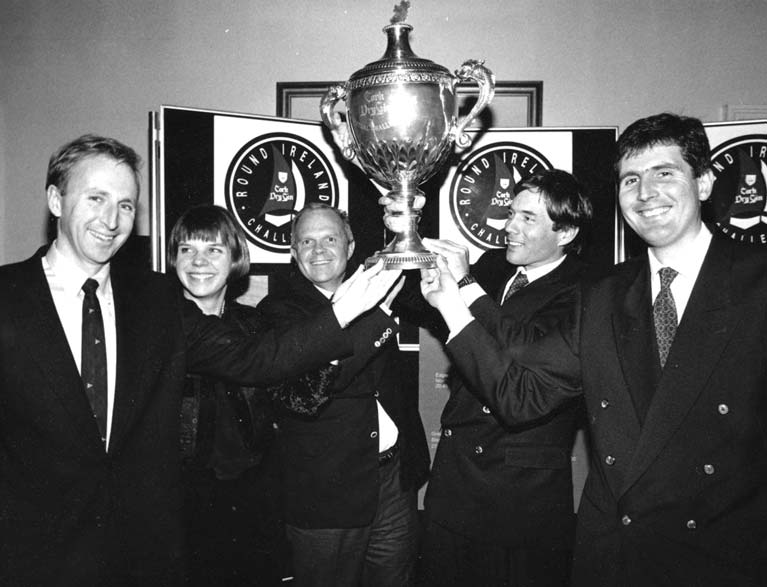 After establishing a round Ireland record in September 1993 which was to stand for 22 years, the Lakota crew celebrating in the National YC are (left to right) Con Murphy, Cathy MacAleavey, the late Steve Fossett, Dave Scully and Brian Thompson. Brian Thompson is this weekend trialling a Sun Fast 3300 in the Solent with sails which – when approved – will go to the new boat in Ireland.
After establishing a round Ireland record in September 1993 which was to stand for 22 years, the Lakota crew celebrating in the National YC are (left to right) Con Murphy, Cathy MacAleavey, the late Steve Fossett, Dave Scully and Brian Thompson. Brian Thompson is this weekend trialling a Sun Fast 3300 in the Solent with sails which – when approved – will go to the new boat in Ireland.
In a month or so the new boat currently in Dun Laoghaire will be sailed to her home port of Kinsale, where’s she’ll be known as Cinnamon Girl. The waiting list for a fresh-out-of-the-wrapper Sun Fast 3300 is now pushing towards the six months mark, so the Kinsale owner (who remains anonymous for the moment) deserves every congratulation on placing an early order for what is now one of the hottest boats on the block.
Meanwhile, the fact that we can’t get to sail one in Ireland just yet gives us another opportunity to run the vid showing Ken Read and Suzy Leech racing one of the first Sun Fast 3300s in America to two-handed victory in the Fort Lauderdale to Key West Race at the end of January.
If we really want to promote sailing, this brief movie should be required viewing. The sun shines, the breeze is steady, and two very experienced sailors are effortlessly getting the best out of a perfectly set up and very interesting boat with helming skills which minimize sail trim effort and conserve energy for when it is really needed. In a distance race, conditions are inevitably going to change at some stage. But while they are briefly steady, you make the best of it, and the boat moves sweetly along in a style which is a joy to behold.
Solo Sailing Conference Offers Charter of Performance Yachts
Irish solo sailing fans may be interested in the annual Solo Racing Festival at the Royal Southern Yacht Club, Hamble on Saturday 12th March.
Given the Figaro race is coming to Dun Laoghaire in August a talk on the Artemis Academy with John Thorn (Figaro 2) will be of particular interest.
Owen Clarke's designer Merfyn Owen, who lives in Hamble will be attending as well as colleagues from their brokerage partners Boatshed Performance.
So whether your interest be solo sailing or short-handed sailing in general they will be there to answer questions on design, construction, as well as sale/purchase and charter of offshore performance yachts.
The Race Fair is an open house from 10.00 for race organisers to meet and greet potential skippers from; Global Ocean/Class 40, Mocra, UK mini group, RORC, SORC, Biscay Challenge, AZAB. Floating boat show, 8 boats including the OC class 40, 2 minis, A35, J105, Figaro 2, Sunfast 3200.
There is a Book Signing, Alex Bennett signing copies of High Seas High Stakes and showing Fuji DVD Mike Golding is opening the talks at 11,00.
Followed by:
Winning Mind Set with Ian Brown, sports psychologist
Global Ocean race with Oliver Dewar
Two Star/Ostar with John Lewis, RWYC
30m trimaran design with Nigel Irens (Idec, Sodebo)
Artemis Academy first term report with John Thorn (Figaro 2)
Route du Rhum with Marco Nannini, (class 40)
all in the spendid riverside setting of the Royal Southern Yacht Club, Hamble.
More HERE.


























